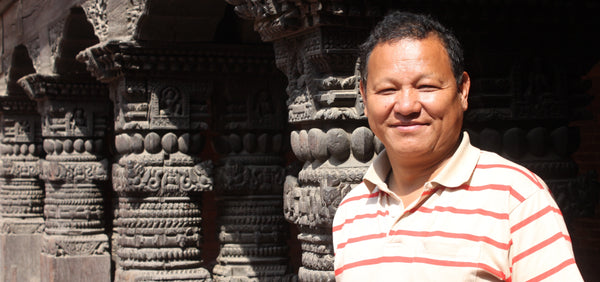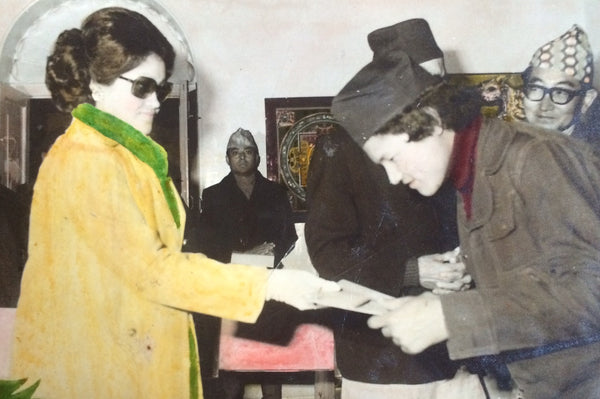Mukti Singh Thapa
Mukti Singh Thapa is one of Nepal's foremost traditional painters and is credited with reviving the Newar Design style from the 13th - 16th centuries. He is a master of the iconography and styles of this period and paints exclusively in traditional mineral and vegetable pigments. His rich color palette, precise lines, complex designs and unparalleled creativity have brought him acclaim in Nepal and around the world.

Thapa was born in 1957 in the central Nepali town of Bandipur, high in the Himalayan foothills with sweeping views over the snowcapped mountains. He grew up in a poor farming family and from a young age Thapa was captivated by drawing, often sketching little flowers or animals that he would sell to the girls in his village. It was when he was twelve that he met his destiny. As the road between Kathmandu and Pokhara was being built, an unfortunate accident killed three of the workmen. At the puja to commemorate the workman's death there was a beautiful mandala painting. The young Thapa was captivated and knew immediately that he wanted to create paintings like that one. With no opportunities to study art in his small hometown, Thapa left for Kathmandu at age 15 to pursue his dream to paint.
He was taught by senior Tibetan monks who came to Kathmandu from Dharamasala to paint a monastery at Nepal's holiest shrine, the Boudhanath stupa. They taught him the Tibetan style, which is marked by fantastical landscaped backgrounds with rivers, mountains and clouds and he became very skilled. Yet, he was not content to copy others and join the mainstream.
Thapa went to temples, monasteries and museums and discovered different styles. He was captivated by the classical Newar Design style, which was popular throughout the Himalaya from the 13th - 16th centuries, and practiced for years to perfect his technique. This style covered every inch with designs. Thapa preferred this style because it could be used in any medium and across many artistic endeavors. Tibetan style could be painted, but Design style could also be used to decorate temples and monasteries, and could be painted, carved, or worked in metals.
In 1977, Thapa submitted a painting to Nepal's National Art Competition and, at only 20 years old, won 1st Prize (see photo, receiving the award from Nepal's Queen) when he shocked the Nepal art world by revealing the traditional Newar Design style. His Mahisamvhrara Mandala painting was in sharp contrast to the Tibetan landscape style that other painters were using at the time. In 1988 he won again when he submitted two paintings of Chakrasamvhara Mandala, one in Design style and the other in Tibetan style, displaying his masterful skill in both techniques.
Although there are rules for Buddhist art that must be followed, Thapa's works are not copies of previous work. Instead, he uses his mastery of the iconography and artistic creativity to bring his personal touch to each work.
Given his expertise of the subject and skill of painting, Thapa was invited to Lo Manthang in 2007 to teach local artists the traditional Newari style as part of an American Himalayan Foundation project. Lo Manthang is the 14th century capital of the former Himalayan Kingdom of Mustang, now a part of Nepal jutting into the Tibetan plateau, and an international project had started to restore its 15th century monasteries. He instructed the local artists for six weeks in Lo Manthang and then taught them five successive winters in Kathmandu, when the harsh winters descended on Mustang.
In recent years, Thapa has devoted more of his energy to a new style. In his desire to express his artistic creativity, he portrays contemporary philosophy using traditional technique. Here, he can truly express himself and controversial subjects including sexuality, religion, and human rights. Again, Thapa is pushing boundaries and solidifying his position as a true artistic master.
Thapa's work has been displayed in museums around the world, including the Rubin Museum in New York City and the Fukuoka Asian Art Museum in Japan. Additionally, his art is in private collections worldwide, including numerous works in Bill Gates' collection.
To see Mukti Singh Thapa's work, please visit his gallery.




